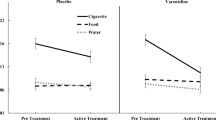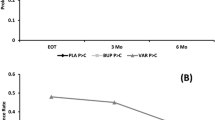Abstract
Rationale
Varenicline may aid smoking cessation by attenuating smoking behavior and reward. We compared the effects of varenicline versus placebo on smoking behavior and reward, assessed both prospectively and retrospectively, and related these effects to subsequent success in a brief simulated quit attempt with medication.
Materials and methods
Smokers (n = 124) with high or low interest in quitting smoking participated in a double-blind crossover study of varenicline versus placebo effects on smoking behavior and reward. In each of two phases, subjects received a week of medication run-up with varenicline (0.5 mg, b.i.d.) or placebo while continuing to smoke, followed the next week by an attempt to quit while on medication. At the end of each run-up week, subjects completed retrospective measures of smoking reward (liking) and number of cigarettes over the prior 24 hrs, and they provided an expired air carbon monoxide (CO) measure. They then completed a prospective session in which they ad lib smoked and rated the rewarding effects of one of their preferred cigarettes while blind to brand.
Results
Varenicline decreased smoking reward significantly in the prospective assessment, but only marginally in the retrospective assessment. Varenicline did not alter smoking behavior prospectively, but did reduce CO and retrospective report of smoking amount. None of these effects of varenicline predicted subsequent days of abstinence due to varenicline.
Conclusions
During medication run-up, varenicline decreases acute smoking reward and may attenuate smoking behavior, but these effects do not appear to directly predict varenicline’s influence on smoking abstinence in a short-term test.



Similar content being viewed by others
References
al’Absi M, Hatsukami D, Davis GL, Wittmers LE (2004) Prospective examination of effects of smoking abstinence on cortisol and withdrawal symptoms as predictors of early smoking relapse. Drug Alc Depend 73:267–278
Aubin H-J, Bobak A, Britton JR, Concken C, Billing CB, Gong J, Williams KE, Reeves KR (2008) Varenicline versus transdermal nicotine patch for smoking cessation: results from a randomized open-label trial. Thorax 63:717–724
Cousins MS, Stamat HM, deWit H (2001) Acute doses of d-amphetamine and bupropion increase cigarette smoking. Psychopharmacology 157:243–253
Gonzales D, Rennard SI, Nides M, Oncken C, Azoulay S, Billing CB, Watsky EJ, Gong J, Williams KE, Reeves KR (2006) Varenicline, an a4b2 nicotinic acetylcholine receptor partial agonist, vs. sustained-release bupropion and placebo for smoking cessation. JAMA 296:47–55
Heatherton TF, Kozlowski LT, Frecker RC, Fagerstrom K-O (1991) The Fagerstrom Test for Nicotine Dependence: a revision of the Fagerstrom Tolerance Questionnaire. Br J Addict 86:1119–1127
Huitema BE (1980) Analysis of covariance and alternatives. Wiley, New York
Jorenby DE, Hays JT, Rigotti NA, Azoulay S, Watsky EJ, Williams KE, Billing CB, Gong J, Reeves KR (2006) Efficacy of varenicline, an a4b2 nicotinic acetylcholine receptor partial agonist, vs placebo or sustained-release bupropion for smoking cessation. JAMA 296:56–63
Kaufmann V, Jepson C, Rukstalis M, Perkins KA, Audrain-McGovern J, Lerman C (2004) Subjective effects of an initial dose of nicotine nasal spray predict treatment outcome. Psychopharmacology 172:271–276
Mihalak KB, Carroll FI, Luetje CW (2006) Varenicline is a partial agonist at α4β2 and a full agonist at α7 neural nicotinic receptors. Mol Pharmacol 70:801–805
O’Connor EC, Parker D, Rollema H, Mead AN (2010) The α4β2 nicotinic acetylcholine-receptor partial agonist varenicline inhibits both nicotine self-administration following repeated dosing and reinstatement of nicotine seeking in rats. Psychopharmacology 208:365–376
Oncken C, Gonzales D, Nides M, Rennard S, Watsky E, Billing CB, Anziano R, Reeves KR (2006) Efficacy and safety of the novel selective nicotinic acetylcholine receptor partial agonist, varenicline, for smoking cessation. Arch Intern Med 166:1571–1577
Patterson F, Jepson C, Strasser AA, Loughead J, Perkins KA, Gur RC, Frey JM, Siegel S, Lerman C (2009) Varenicline improves mood and cognition during smoking abstinence. Biol Psychiatry 65:144–149
Perkins KA (2009) Sex differences in nicotine reinforcement and reward: influences on the persistence of tobacco smoking. In: Bevins R, Caggiula AR (eds) The motivational impact of nicotine and its role in tobacco use. Springer, New York, pp 143–169
Perkins KA, Grobe JE, D’Amico D, Fonte C, Wilson A, Stiller RL (1996) Low-dose nicotine nasal spray use and effects during initial smoking cessation. Exper Clin Psychopharmacol 4:157–165
Perkins KA, Gerlach D, Vender J, Grobe JE, Meeker J, Hutchison S (2001) Sex differences in the subjective and reinforcing effects of visual and olfactory cigarette smoke stimuli. Nic Tobacco Res 3:141–150
Perkins KA, Broge M, Gerlach D, Sanders M, Grobe JE, Cherry C, Wilson AS (2002) Acute nicotine reinforcement, but not chronic tolerance, predicts withdrawal and relapse after quitting smoking. Health Psychol 21:332–339
Perkins KA, Stitzer M, Lerman C (2006) Medication screening for smoking cessation: a proposal for new methodologies. Psychopharmacology 186:628–636
Perkins KA, Lerman C, Stitzer ML, Fonte CA, Briski JL, Scott JA, Chengappa KNR (2008) Development of procedures for early screening of smoking cessation medications in humans. Clin Pharmacol Ther 84:216–221
Perkins KA, Lerman C, Fonte CA, Mercincavage M, Stitzer ML, Chengappa KRN, Jain A (2010) Cross-validation of a new procedure for early human screening of cessation medications. Clin Pharmacol Ther, in press
Rollema H, Chambers LK, Coe JW, Glowa J, Hurst RS, Lebel LA, Lu Y, Mansbach RS, Mather RJ, Rovetti CC, Sands SB, Schaeffer E, Schulz DW, Tingley FD, Williams KE (2007) Pharmacological profile of the α4β2 nicotinic acetylcholine receptor partial agonist varenicline, an effective smoking cessation aid. Neuropharmacol 52:985–994
Shiffman S, Hufford M, Hickox M, Paty JA, Gnys M, Kassel JD (1997) Remember that? A comparison of real-time versus retrospective recall of smoking lapses. J Consult Clin Psychol 65:292–300
Shiffman S, Ferguson SG, Gwaltney CJ (2006) Immediate hedonic response to smoking lapses: relationship to smoking relapse, and effects of nicotine replacement therapy. Psychopharmacology 184:608–618
Sofuoglu M, Herman AI, Mooney M, Waters AJ (2009) Varenicline attenuates some of the subjective and physiological effects of intravenous nicotine in humans. Psychopharmacology 207:153–162
Stoops WW, Vansickel AR, Glaser PEA, Rush CR (2008) The influence of acute varenicline administration on smoking and eating behavior in humans. Pharmacol Biochem Behav 91:165–169
Transdermal Nicotine Study Group (1991) Transdermal nicotine for smoking cessation. JAMA 266:3133–3138
Wakefield M, Morley C, Horan JK, Cummings KM (2002) The cigarette pack as image: new evidence from tobacco industry documents. Tob Control 22:173–180
West R, Baker CL, Cappelleri JC, Bushmakin AG (2008) Effect of varenicline and bupropion SR on craving, nicotine withdrawal symptoms, and rewarding effects of smoking during a quit attempt. Psychopharmacology 197:371–377
Westman EC, Behm FM, Rose JE (1996) Dissociating the nicotine and airway sensory effects of smoking. Pharmacol Biochem Behav 53:309–315
Acknowledgments
This research was supported by NIH Grant P50 CA143187. The authors thank Pfizer for providing varenicline and matching placebo for this study and John S. Slifka, Zachary Chakan, Roy Chengappa MD, and Abishek Jain MD for their valuable assistance.
Conflict of interest
K Perkins has served as a consultant for GlaxoSmithKline.
C Lerman has served as a consultant or has received research funding from GlaxoSmithKline, Pfizer, Novartis, and AstraZeneca. Research support received was unrelated to the current study.
No other authors have any potential conflicts of interest to report.
Author information
Authors and Affiliations
Corresponding author
Rights and permissions
About this article
Cite this article
Perkins, K.A., Mercincavage, M., Fonte, C.A. et al. Varenicline’s effects on acute smoking behavior and reward and their association with subsequent abstinence. Psychopharmacology 210, 45–51 (2010). https://doi.org/10.1007/s00213-010-1816-9
Received:
Accepted:
Published:
Issue Date:
DOI: https://doi.org/10.1007/s00213-010-1816-9




